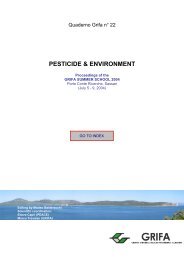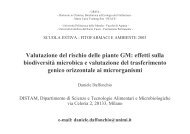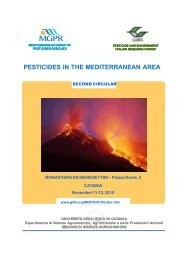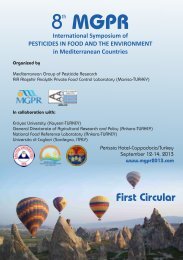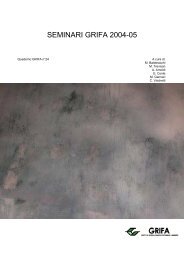International Congress BIOLOGICAL PRODUCTS - Gruppo di ...
International Congress BIOLOGICAL PRODUCTS - Gruppo di ...
International Congress BIOLOGICAL PRODUCTS - Gruppo di ...
Create successful ePaper yourself
Turn your PDF publications into a flip-book with our unique Google optimized e-Paper software.
25<br />
EFFICACY EVALUATION OF <strong>BIOLOGICAL</strong> CONTROL AGENTS AGAINST<br />
PLASMOPARA VITICOLA<br />
Ilaria Pertot, Federica De Luca, Antonella Vecchione, Luca Zulini<br />
Istituto Agrario <strong>di</strong> San Michele all’A<strong>di</strong>ge, via E. Mach 1, S. Michele all’A<strong>di</strong>ge (TN)<br />
ilaria.pertot@ismaa.it<br />
Keywords<br />
downy mildew, Plasmopara viticola, biological control agents, organic agriculture.<br />
Introduction<br />
Downy mildew causal agent, Plasmopara viticola (Berk. et Curt.) Berl. et De Toni, is one of the most important<br />
grapevine pathogens, causing great losses if no protective treatments are applied (Kortekamp, 1997).<br />
Nowadays consumer and farmer are much more concerned about food, health and environment safety (Butt,<br />
2001). The con<strong>di</strong>tions for using copper will be restricted by European Union by fixing a ceiling on use expressed<br />
in terms of kilograms of copper per hectare per year in organic agriculture. Antagonist microorganisms could be<br />
a possible alternative to copper in downy mildew controlling. Epidemiological characteristics of downy mildew<br />
probably would not allow a complete field control based on a single biocontrol agent (BCA). A possible solution<br />
for improving efficacy of BCA could be the integration of several micro-organisms with <strong>di</strong>fferent action<br />
mechanisms on specific stages of <strong>di</strong>sease: i) during oospore overwintering and germination, for primary<br />
inoculum reduction ii) and during sporangia germination for protection against secondary infections.<br />
Materials and methods<br />
Micro-organisms were isolated from grapevine leaf material and rhizosphere of 18 <strong>di</strong>fferent vineyards located in<br />
the north –east of Italy. Vineyards were abandoned and chemically untreated for at least three years. Microorganisms<br />
were isolated on potato dextrose agar, malt agar and nutrient sucrose agar and grown at 20°C. Several<br />
isolation methods were used: inocula were based on leaf washing water, necrotic leaf portions grounded in sterile<br />
water with mortar and pestle, necrotic leaf pieces, infected leaf <strong>di</strong>sh maintained in contact with naturally<br />
degraded leaf material and root surface material. For each kind of material used, all morphologically <strong>di</strong>fferent<br />
colonies of fungi and bacteria were collected. A sample of 46 isolates was evaluated for sporangia germination<br />
and infection inhibition activity. A sample of 33 isolates was evaluated for overwintering oospores inhibition<br />
activity.<br />
The evaluation methods used were:<br />
i) oospore germination inhibition, based on a mo<strong>di</strong>fied floating leaf <strong>di</strong>sk method (Hill);<br />
ii) inhibition of sporangia germination, based on reduction percentage of sporangia germination in a 1:1<br />
water solution of the isolate culture broth and P. viticola sporangia;<br />
iii) infection inhibition, based on the reduction of the number of sporangiophore developed on isolate<br />
culture broth treated leaves.<br />
Results and <strong>di</strong>scussion<br />
Several micro-organisms have induced a partial inhibition of sporangia germination (tab. 1), but the complete<br />
control of infection on leaf can be achieved with only few of them.<br />
PDF creato con FinePrint pdfFactory versione <strong>di</strong>mostrativa http://www.secom.re.it/fineprint<br />
123



